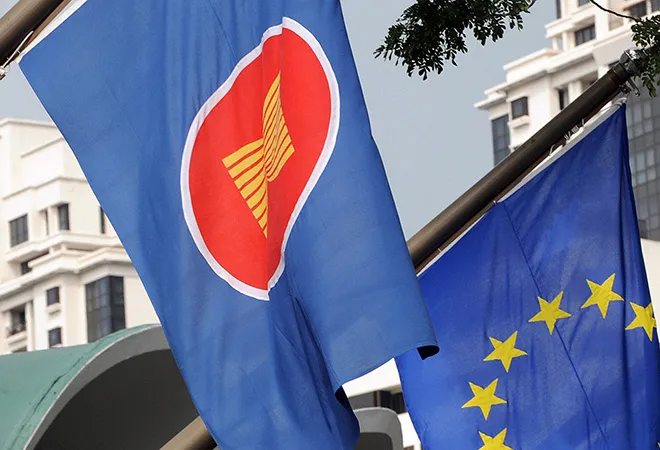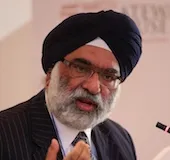
The EU-ASEAN 45
th commemorative summit was held on 14 December. A leader’s summit was held for the very first time. Since 2020, the EU-ASEAN engagement led to a strategic partnership with a commitment to work towards
enhancing ‘prosperity, promoting security, strengthening resilience, and improving sustainable connectivity.’
An overview
Over 45 years, EU-ASEAN relations progressed steadily. In 1977, a formal dialogue relationship was established. In 2007, we saw the adoption of the Nuremberg Declaration for the EU-ASEAN enhanced partnership. The EU acceded to ASEAN’s Treaty of Amity and Cooperation and adopted the Bandar Seri Begawan plan of action, 2013-2017 in 2012. Next, in 2015, the EU opened a separate mission to ASEAN in Jakarta. This was followed by the second ASEAN-EU plan of action for 2018-2022. The relationship was further upgraded to a strategic partnership in 2020. Now at the EU-ASEAN Commemorative Summit, a new plan of action for 2023-2027 was adopted.
The EU Support to Higher Education in the ASEAN Region (SHARE) project concluded after seven years. It impacted ASEAN higher education mobility and increased EU-ASEAN people-to-people connectivity.
The EU is not a part of
the East Asia Summit (EAS), the ASEAN+1 summits or ADMM+. It is part of
the ASEAN Regional Forum (ARF) and has foreign minister-level meetings with ASEAN. Despite its commitment to ASEAN centrality, it is not fully integrated with ASEAN-centric institutions.
The joint statement notes the EU’s interest in joining the EAS.
The Commemorative Summit and its side events
Several parallel events preceded the Commemorative Summit. These were efforts to engage EU and ASEAN youth and the private sector, and to expand people-to-people engagement, both physically and virtually.
In December, the EU Support to Higher Education in the ASEAN Region (SHARE) project concluded after seven years.
It impacted ASEAN higher education mobility and increased EU-ASEAN people-to-people connectivity. Both EU-SHARE and the Erasmus Plus programmes have benefited researchers, higher institutions of education and
students, and their assessments on the further development of these programmes were shared.
Since the EU is pursuing its Global Gateway project and trying to link it to ASEAN’s Connectivity Master Plan 2025, it wants to use this education engagement to see how skills, democratic education, public health, transition to a green economy, and digital connectivity could be brought in, since these require action that goes beyond government interaction. The EU-ASEAN Youth Summit was held on 13
th December and was the conclusion of the EU-ASEAN Young Leaders Forum which has an annual set of events. The YLF was created in 2018 to engage EU and ASEAN youth to exchange perspectives on the strategic partnership.
The 10
th ASEAN-EU Business Summit was also held on 13th December and its theme was ‘Deepening ASEAN-EU trade: sustainable development for all.’ This explored EU-ASEAN economic cooperation and saw the participation of several EU commissioners, ASEAN leaders along with business leaders from several European countries.
The EU has free trade agreements in force with ASEAN member states such as Singapore and Vietnam, while it seeks to hasten similar negotiations with Indonesia, the Philippines, Malaysia, and Thailand.
The Commemorative Summit was co-chaired by Charles Michel, the President of the European Council and ASEAN Chairman Hun Sen, Prime Minister of Cambodia, who had symbolically handed over the chairmanship to Indonesia at the ASEAN summit in November in Phnom Penh but continues as chairman for the current year. This was a political forum for the EU and ASEAN to manifest their common goal of a rules-based international order with respect for international law and the pursuit of effective multilateralism.
ASEAN is the EU's third largest trading partner outside Europe. It follows the United States (US) and China; the EU was the second-largest provider of FDI in 2021.
The EU has free trade agreements in force with ASEAN member states such as Singapore and Vietnam, while it seeks to hasten similar negotiations with Indonesia, the Philippines, Malaysia, and Thailand. The EU began trade negotiations with individual ASEAN countries such as Singapore and Malaysia in 2010, Vietnam in 2012, Thailand in 2013, the Philippines in 2015, and Indonesia in 2016. Though the EU would prefer an FTA with ASEAN, the EU sanctions on Cambodia and Myanmar, due to human rights issues ensure that for now, the EU will pursue bilateral trade agreements.
The Summit discussed
cooperation in the Indo-Pacific and to
harmonise the nascent EU Indo-Pacific strategy and the ASEAN Outlook on the Indo-Pacific (AOIP). The AOIP and the EUIP strategy seek regional stability, security, prosperity, and sustainable development, much of which coincide with the objectives of the AOIP. The EU-ASEAN Commemorative Summit had as its main objective, the continuation of the commitment of both, the EU and ASEAN to a rule- based international order with the UN Charter at its core.
The EU-ASEAN plan of action 2023-2027 has six pillars of cooperation and was worked out in advance and agreed upon at the summit. Though the EU partnership with ASEAN was elevated to a strategic partnership it now seeks to have a commitment by ASEAN to hold regular summits at the leader’s level.
The strategic partnership emerges since both agreed to work towards sustainability, recognise that 10 million people travel between the EU and ASEAN annually, and EU ASEAN trade is nearly 250 billion euros which include about 140 billion euros of ASEAN exports to the EU and about 100 billion euros of EU exports to ASEAN. Security challenges are mentioned but these are mainly dealing with training for counterterrorism, cyber, and maritime security. The
EU-ASEAN strategic partnership document mentions four pillars: economic cooperation, security cooperation, sustainable connectivity, and sustainable development. While these by themselves may sound a bit circular, economic cooperation is intended to include a circular economy, fiscal stability, sustainable financing, fair trade, labour rights, and employment generation.
The sustainable connectivity pillar looks at diversifying transport linkages, promoting secure and renewable energy supplies, cooperating in the field of education, research and innovation, and promoting culture and tourism.
Security cooperation focuses on preserving peace and stability, dealing with transnational crime and counterterrorism and cooperating on cybersecurity and maritime security. The sustainable connectivity pillar looks at diversifying transport linkages, promoting secure and renewable energy supplies, cooperating in the field of education, research and innovation, and promoting culture and tourism. The last pillar emphasises human rights, climate change and transition for clean energy, smart cities, blue economy, and environmental protection.
The Global Gateway is expected to enhance smart clean and secure linkages between the EU and ASEAN. It will promote the green transition and sustainable connectivity, which are now prioritised in ASEAN.
The EU budget and member states public funding is expected to leverage 10 billion euros in investments for ASEAN by 2027.
The 50-paragraph joint statement is long on promise and hyperbole like such documents tend to be. It is a reiteration of many goals and ongoing programmes and a statement of intent that the EU is now more interested in ASEAN given the evolving geostrategic and geoeconomic situation.
Diverging interests
It could not paper over the differences over Taiwan. While the South China Sea, which is an ASEAN priority finds elaborate mention, the issue of Taiwan was dropped despite EU keenness to include it. ASEAN is unwilling to go along with other partners to be critical of China, beyond what they have said to China on the South China Sea.
While the South China Sea, which is an ASEAN priority finds elaborate mention, the issue of Taiwan was dropped despite EU keenness to include it.
Similarly, on Ukraine, there is an elaborate paragraph, but all ASEAN countries were not on the same page as the EU. The disunity among ASEAN on Ukraine and criticism of Russia manifests itself. In the discussions on Myanmar, the EU would like to be more forceful but is going along with the ASEAN leadership and the Five-Point Consensus. There is now hope that Indonesia would be able to implement it better than Cambodia did.
Conclusion
The EU with its Indo-Pacific policy, is trying to play a bigger role in the region. Its main thrust is to have better economic access to the growing ASEAN market. It is a major player for trade and investment and wants to expand that to green sustainable and digital economy. If in the process, it acquires a better strategic interface, the EU will be happy.
On its part, the ASEAN is happy that it is being wooed by larger groupings like the EU at a time when both its unity and centrality have come into question.
The views expressed above belong to the author(s). ORF research and analyses now available on Telegram! Click here to access our curated content — blogs, longforms and interviews.



 The EU-ASEAN 45th commemorative summit was held on 14 December. A leader’s summit was held for the very first time. Since 2020, the EU-ASEAN engagement led to a strategic partnership with a commitment to work towards
The EU-ASEAN 45th commemorative summit was held on 14 December. A leader’s summit was held for the very first time. Since 2020, the EU-ASEAN engagement led to a strategic partnership with a commitment to work towards  PREV
PREV


